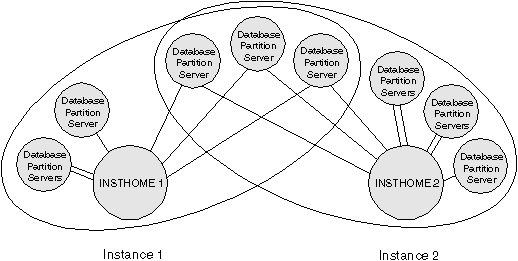

In DB2 Extended Enterprise Edition, an instance contains all the database partition servers (nodes) that were defined to take part in a given partitioned database system. The database partition servers are defined in the db2nodes.cfg file as nodes. An instance has its own databases and instance directory. The instance directory contains the database manager configuration file, system database directories, node directories, and node configuration file. See "Instance Directory" for more information.
Each instance has different security from other instances on the same machine. This is shown in Figure 9, which shows two separate instances. Instance 1 contains six database partition servers and Instance 2 contains eight database partition servers. The two instances appear to overlap, but this is due to the assignment of two database partition servers to each of the three machines in the middle of the figure. (Multiple database partition servers are indicated when more than one line is shown between a database partition server and the instance directory.) The db2nodes.cfg file of Instance 1 will not list the database partition servers that belong to Instance 2, and the converse.

You can have multiple instances on the same machine, with each configured differently:
Each instance is owned by a user known as the instance owner. For information about generating instances, see Chapter 17. "Working with Instances".
The instance owner has SYSADM authority for all databases that belong to the instance. Because the instance owner has almost complete control over the instance, this user ID can:
The instance owner cannot remove an instance. This requires root authority.
A one-to-one correspondence exists between an instance and an instance owner; that is, a user cannot own more than one instance. (However, an instance owner may possess authorizations for other instances, up to, and including, SYSADM). In addition to this, each instance must have a separate home directory.